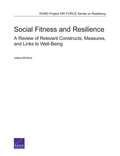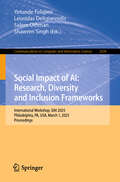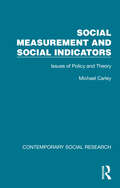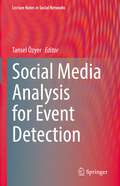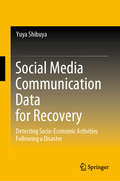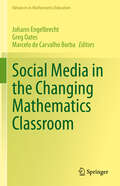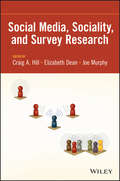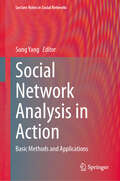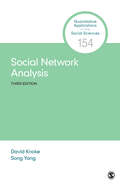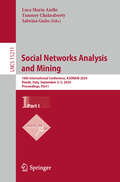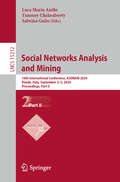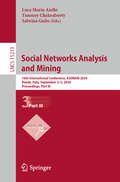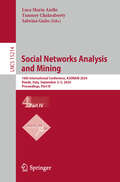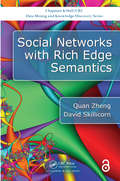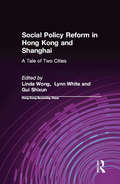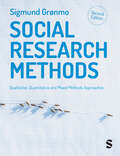- Table View
- List View
Social Exclusion in Later Life: Interdisciplinary and Policy Perspectives (International Perspectives on Aging #28)
by Kieran Walsh Thomas Scharf Sofie Van Regenmortel Anna WankaDrawing on interdisciplinary, cross-national perspectives, this open access book contributes to the development of a coherent scientific discourse on social exclusion of older people. The book considers five domains of exclusion (services; economic; social relations; civic and socio-cultural; and community and spatial domains), with three chapters dedicated to analysing different dimensions of each exclusion domain. The book also examines the interrelationships between different forms of exclusion, and how outcomes and processes of different kinds of exclusion can be related to one another. In doing so, major cross-cutting themes, such as rights and identity, inclusive service infrastructures, and displacement of marginalised older adult groups, are considered. Finally, in a series of chapters written by international policy stakeholders and policy researchers, the book analyses key policies relevant to social exclusion and older people, including debates linked to sustainable development, EU policy and social rights, welfare and pensions systems, and planning and development. The book’s approach helps to illuminate the comprehensive multidimensionality of social exclusion, and provides insight into the relative nature of disadvantage in later life. With 77 contributors working across 28 nations, the book presents a forward-looking research agenda for social exclusion amongst older people, and will be an important resource for students, researchers and policy stakeholders working on ageing.
Social Fitness and Resilience: A Review of Relevant Constructs, Measures, and Links to Well-Being
by Juliana McgeneOne of a series of reports designed to support Air Force leadership in promoting resilience among Airmen, its civilian employees, and Air Force family members, this report examines social fitness, or the combination of resources from social connections that influence how individuals respond to stressful circumstances. It assesses the current social fitness constructs and measures in scientific literature to identify methods of increasing social connectedness and support among U. S. Airmen and their families.
Social Impact of AI: International Workshop, SIAI 2025, Philadelphia, PA, USA, March 1, 2025, Proceedings (Communications in Computer and Information Science #2599)
by Leonidas Deligiannidis Yetunde Folajimi Salem Othman Shawren SinghThe workshop proceedings SIAI 2025 constitutes the refereed proceedings of the fourth International Workshop on Social Impact of AI, SIAI 2025, which was held in Philadelphia, PA, USA, in March 2025. The 8 full papers, 4 short papers, and one poster presented in these proceedings were carefully reviewed and selected from 26 submissions. SIAI-ReDI 2025 centered on the development and assessment of inclusive AI frameworksthat prioritize ethical design, equitable deployment, and cultural context. The workshop&’scall for papers invited submissions across a range of urgent topics, including: Algorithmic fairness and transparencyInclusive AI education and workforce strategiesAI in marginalized and underrepresented communitiesIntersectionality, gender, and accessibility in AICross-cultural AI governance and regulationPublic trust, participatory AI, and responsible design
Social Inequality in Japan: Social Inequality In Japan (Nissan Institute/Routledge Japanese Studies)
by Sawako ShirahaseJapan was the first Asian country to become a mature industrial society, and throughout the 1970s and the 1980s, was viewed as an ‘all-middle-class society’. However since the 1990s there have been growing doubts as to the real degree of social equality in Japan, particularly in the context of dramatic demographic shifts as the population ages whilst fertility levels continue to fall. This book compares Japan with America, Britain, Italy, France, Germany, Sweden and Taiwan in order to determine whether inequality really is a social problem in Japan. With a focus on impact demographic shifts, Sawako Shirahase examines female labour market participation, income inequality among households with children, the state of the family, generational change, single person households and income distribution among the aged, and asks whether increasing inequality and is uniquely Japanese, or if it is a social problem common across all of the societies included in this study. Crucially, this book shows that Japan is distinctive not in terms of the degree of inequality in the society, but rather, in how acutely inequality is perceived. Further, the data shows that Japan differs from the other countries examined in terms of the gender gap in both the labour market and the family, and in inequality among single-person households – single men and women, including lifelong bachelors and spinsters – and also among single parent households, who pay a heavy price for having deviated from the expected pattern of life in Japan. Drawing on extensive empirical data, this book will be of great interest to students and scholars interested in Japanese culture and society, Japanese studies and social policy more generally.
Social Issues in China: Gender, Ethnicity, Labor, and the Environment
by Zhidong Hao Sheying ChenSince 1978, the opening up and reform in China has brought tremendous economic and social changes. While China's economic progress has been commendable, the social problems that go with economic changes have raised serious concerns. Some of those concerns are related to gender, ethnic, labor, and environmental issues. This book is about what has happened in these arenas in China since the opening up and reform in 1978. The study of gender, ethnicity, labor, and environment touches on some of the fundamental problems of modernization, especially the development of individuals and groups. So even though gender, ethnicity, labor, and environment seem to be separate issues, they are in fact related in some fundamental ways. That's what this book will explore as well. To understand is one thing and to do is another. This book also incorporates studies of NGO practices to see how NGOs have helped in transforming gender, ethnic, labor, and environment interplay. Our study of NGOs in helping improve such interplay sheds light on how specifically civil society can prod the state to transform social relations for the better. This book is an attempt to assess the changes, both positive and negative, in gender, ethnic, ethnic, and environmental relations in China especially in the past 30 years of opening up and reform, especially regarding national identity formation.
Social Measurement and Social Indicators: Issues of Policy and Theory (Contemporary Social Research)
by Michael CarleyFor the early pioneers of the social indicator movement, the possibilities of doing social good by developing the tools of social measurement seemed endless. However, in the early 1980s these high, and perhaps naïve, hopes remained unfulfilled, especially for the data needs of the policy-maker. If not pessimistic, administrators and public policy-makers were at least guarded about the usefulness of social indicators as an aid to increasingly complex decision-making.These difficulties reflected both policy-related and methodological issues. Originally published in 1981, Social Measurement and Social Indicators is not a ‘how-to’ guide on the construction of social indicators, but rather a critical and optimistic view of these central issues, as embodied in the literature and in practice at the time. Michael Carley contrasts some of the basic problems of social measurement with government’s needs for reliable information, organised by their policy usefulness and statistical sophistication.The book then discusses the critical relationship between social indicators and social theories and models, as well as the role of social information in the policy process. Later chapters look at the audience, the problems, and the prospects for national social reports; and explore in detail three different applications of social indicators to urban analysis. Throughout the book helpful examples are drawn from North American, UK and European experience.Social Measurement and Social Indicators is aimed at a cross-disciplinary audience in government and the universities. For students, it will serve as a compact introduction to the broad field of social indicators; for administrators, it explores philosophical and measurement problems and suggests criteria for interpretation; for researchers, it places social indicator efforts into a wider policy analysis perspective – with its inescapable political value judgemental, and bureaucratic aspects.
Social Media Analysis for Event Detection (Lecture Notes in Social Networks)
by Tansel ÖzyerThis book includes chapters which discuss effective and efficient approaches in dealing with various aspects of social media analysis by using machine learning techniques from clustering to deep learning. A variety of theoretical aspects, application domains and case studies are covered to highlight how it is affordable to maximize the benefit of various applications from postings on social media platforms. Social media platforms have significantly influenced and reshaped various social aspects. They have set new means of communication and interaction between people, turning the whole world into a small village where people with internet connect can easily communicate without feeling any barriers. This has attracted the attention of researchers who have developed techniques and tools capable of studying various aspects of posts on social media platforms with main concentration on Twitter. This book addresses challenging applications in this dynamic domain where it is not possible to continue applying conventional techniques in studying social media postings. The content of this book helps the reader in developing own perspective about how to benefit from machine learning techniques in dealing with social media postings and how social media postings may directly influence various applications.
Social Media Communication Data for Recovery: Detecting Socio-Economic Activities Following a Disaster
by Yuya ShibuyaThis book explores the possibility of using social media data for detecting socio-economic recovery activities. In the last decade, there have been intensive research activities focusing on social media during and after disasters. This approach, which views people’s communication on social media as a sensor for real-time situations, has been widely adopted as the “people as sensor” approach. Furthermore, to improve recovery efforts after large-scale disasters, detecting communities’ real-time recovery situations is essential, since conventional socio-economic recovery indicators, such as governmental statistics, are not published in real time. Thanks to its timeliness, using social media data can fill the gap. Motivated by this possibility, this book especially focuses on the relationships between people’s communication on Twitter and Facebook pages, and socio-economic recovery activities as reflected in the used-car market data and the housing market data in the case of two major disasters: the Great East Japan Earthquake and Tsunami of 2011 and Hurricane Sandy in 2012. The book pursues an interdisciplinary approach, combining e.g. disaster recovery studies, crisis informatics, and economics. In terms of its contributions, firstly, the book sheds light on the “people as sensors” approach for detecting socio-economic recovery activities, which has not been thoroughly studied to date but has the potential to improve situation awareness during the recovery phase. Secondly, the book proposes new socio-economic recovery indicators: used-car market data and housing market data. Thirdly, in the context of using social media during the recovery phase, the results demonstrate the importance of distinguishing between social media data posted both by people who are at or near disaster-stricken areas and by those who are farther away.
Social Media in the Changing Mathematics Classroom (Advances in Mathematics Education)
by Johann Engelbrecht Greg Oates Marcelo de Carvalho BorbaThis edited volume gathers contributions from international scholars focusing on social media's role and impact on mathematics education. Social media's integration into pedagogical strategies (from social networking sites to video-sharing platforms) offers the opportunity to enhance learning by fostering connectivity and engagement among students, ultimately improving mathematical understanding in educational settings. This text aims to provide guidance on the facilitation of peer learning and collaboration, as well as highlighting the necessary shift in traditional methods to include cyber assistance in the learning process. The book discusses how social media aligns with social-constructivist theories of learning, its consistency with the process of developing students into independent learners and provides means to ensuring educators remain relevant and connected to students' preferred modes of learning. Challenges and benefits of the use of social media tools in teaching are also detailed. Examining the potential for effective integration of social media in the classroom, this book is a valuable resource for educators, practitioners and researchers interested in mathematics education.
Social Media, Sociality, and Survey Research
by Craig A. Hill Elizabeth Dean Joe MurphyProvides the knowledge and tools needed for the future of survey researchThe survey research discipline faces unprecedented challenges, such as falling response rates, inadequate sampling frames, and antiquated approaches and tools. Addressing this changing landscape, Social Media, Sociality, and Survey Research introduces readers to a multitude of new techniques in data collection in one of the fastest developing areas of survey research.The book is organized around the central idea of a "sociality hierarchy" in social media interactions, comprised of three levels: broadcast, conversational, and community based. Social Media, Sociality, and Survey Research offers balanced coverage of the theory and practice of traditional survey research, while providing a conceptual framework for the opportunities social media platforms allow. Demonstrating varying perspectives and approaches to working with social media, the book features:New ways to approach data collection using platforms such as Facebook and TwitterAlternate methods for reaching out to interview subjectsDesign features that encourage participation with engaging, interactive surveysSocial Media, Sociality, and Survey Research is an important resource for survey researchers, market researchers, and practitioners who collect and analyze data in order to identify trends and draw reliable conclusions in the areas of business, sociology, psychology, and population studies. The book is also a useful text for upper-undergraduate and graduate-level courses on survey methodology and market research.
Social Network Analysis and Mining Applications in Healthcare and Anomaly Detection (Lecture Notes in Social Networks)
by Mehmet Kaya Min-Yuh Day Sleiman Alhajj Kashfia SailunazThis book is an excellent source of knowledge for readers interested in the latest developments in social network analysis and mining, particularly with applications in healthcare and anomaly detection. It covers topics such as sensitivity to noise in features, enhancing fraud detection in financial systems, measuring the echo-chamber phenomenon, detecting comorbidity, and evaluating the effectiveness of mitigative and preventative actions on viral spread in small communities using agent-based stochastic simulations. Additionally, it discusses predicting behavior, measuring and identifying influence, analyzing the impact of COVID-19 on various social aspects, and using UNet for handling various skin conditions. This book helps readers develop their own perspectives on adapting social network concepts to various applications. It also demonstrates how to use various machine learning techniques for tackling challenges in social network analysis and mining.
Social Network Analysis in Action: Basic Methods and Applications (Lecture Notes in Social Networks)
by Song YangThis book offers a balanced view between a basic introduction of Social Network Analysis (SNA) in its methods and application, and advanced topics of data mining techniques and the subsequent SNA analyses. The book stands out as uniquely important contribution to the SNA field because it moves beyond the stage of basic SNA methods. It describes data mining techniques, introducing an online discourse collection platform, ICAS, which is developed by an interdisciplinary team involving Sociologists and Computer Engineer teams with supports of NSF funds.Targeted audiences of this book are students and scholars interested in using SNA techniques to advance their analytics of their respective research areas. This book provides particular utilities to students at the beginner stage of learning SNA basics, and those in their intermediary careers looking to advance their knowledges of what SNA has to offer. The unique features of this book lie in its descriptions of data mining techniques, data processing, and data analytics. The discussions of an online discourse network platform and data processing capabilities present tremendous benefits to those who aspire to mine the massive data of online social networking.
Social Network Analysis: Methods And Examples (Quantitative Applications in the Social Sciences #154)
by David Knoke Song YangDavid Knoke and Song Yang′s Social Network Analysis, Third Edition provides a concise introduction to the concepts and tools of social network analysis. The authors convey key material while at the same time minimizing technical complexities. The examples are simple: sets of 5 or 6 entities such as individuals, positions in a hierarchy, political offices, and nation-states, and the relations between them include friendship, communication, supervision, donations, and trade. The new edition reflects developments and changes in practice over the past decade. The authors also describe important recent developments in network analysis, especially in the fifth chapter. Exponential random graph models (ERGMs) are a prime example: when the second edition was published, P* models were the recommended approach for this, but they have been replaced by ERGMs. Finally, throughout the volume, the authors comment on the challenges and opportunities offered by internet and social media data.
Social Network Analysis: Methods And Examples (Quantitative Applications in the Social Sciences #154)
by David Knoke Song YangDavid Knoke and Song Yang′s Social Network Analysis, Third Edition provides a concise introduction to the concepts and tools of social network analysis. The authors convey key material while at the same time minimizing technical complexities. The examples are simple: sets of 5 or 6 entities such as individuals, positions in a hierarchy, political offices, and nation-states, and the relations between them include friendship, communication, supervision, donations, and trade. The new edition reflects developments and changes in practice over the past decade. The authors also describe important recent developments in network analysis, especially in the fifth chapter. Exponential random graph models (ERGMs) are a prime example: when the second edition was published, P* models were the recommended approach for this, but they have been replaced by ERGMs. Finally, throughout the volume, the authors comment on the challenges and opportunities offered by internet and social media data.
Social Networks Analysis and Mining: 16th International Conference, ASONAM 2024, Rende, Italy, September 2–5, 2024, Proceedings, Part I (Lecture Notes in Computer Science #15211)
by Sabrina Gaito Luca Maria Aiello Tanmoy ChakrabortyThis LNCS conference 4-volume set constitutes the proceedings of the 16th International Conference on Social Networks Analysis and Mining, ASONAM 2024, in Rende, Italy, during September 2–5, 2024. The 33 full papers together with 36 short papers included in this volume were carefully reviewed and selected from 167 submissions. The conference covers a wide spectrum of research contributions to the foundations and applications of social networks.
Social Networks Analysis and Mining: 16th International Conference, ASONAM 2024, Rende, Italy, September 2–5, 2024, Proceedings, Part II (Lecture Notes in Computer Science #15212)
by Sabrina Gaito Luca Maria Aiello Tanmoy ChakrabortyThis LNCS conference 4-volume set constitutes the proceedings of the 16th International Conference on Social Networks Analysis and Mining, ASONAM 2024, in Rende, Italy, during September 2–5, 2024. The 33 full papers together with 36 short papers included in this volume were carefully reviewed and selected from 167 submissions. The conference covers a wide spectrum of research contributions to the foundations and applications of social networks.
Social Networks Analysis and Mining: 16th International Conference, ASONAM 2024, Rende, Italy, September 2–5, 2024, Proceedings, Part III (Lecture Notes in Computer Science #15213)
by Sabrina Gaito Luca Maria Aiello Tanmoy ChakrabortyThis LNCS conference 4-volume set constitutes the proceedings of the 16th International Conference on Social Networks Analysis and Mining, ASONAM 2024, in Rende, Italy, during September 2–5, 2024. The 33 full papers together with 36 short papers included in this volume were carefully reviewed and selected from 167 submissions. The conference covers a wide spectrum of research contributions to the foundations and applications of social networks.
Social Networks Analysis and Mining: 16th International Conference, ASONAM 2024, Rende, Italy, September 2–5, 2024, Proceedings, Part IV (Lecture Notes in Computer Science #15214)
by Sabrina Gaito Luca Maria Aiello Tanmoy ChakrabortyThis LNCS conference 4-volume set constitutes the proceedings of the 16th International Conference on Social Networks Analysis and Mining, ASONAM 2024, in Rende, Italy, during September 2–5, 2024. The 33 full papers together with 36 short papers included in this volume were carefully reviewed and selected from 167 submissions. The conference covers a wide spectrum of research contributions to the foundations and applications of social networks.
Social Networks and their Economics: Influencing Consumer Choice
by Daniel BirkeReveals how consumer choice can be better understood and influenced using social networks analysis (SNA) Intuitively, we all appreciate that we can be influenced by our friends and peers in what we do, how we behave, and what products we consume. Until recently, it has been difficult to measure this interdependence, mainly because data on social networks was difficult to collect and not readily available. More and more companies such as mobile phone carriers or social networking sites such as Facebook are collecting such data electronically. Daniel Birke illustrates in compelling real-world case studies how companies use social networks for marketing purposes and which statistical analysis and unique datasets can be used. Social Networks and their Economics: Explores network effects and the analysis of social networks, whilst providing an overview of the state-of-the art research. Looks at consumption interdependences between friends and peers: Who is influencing who through which channels and to what degree? Presents statistical methods and research techniques that can be used in the analysis of social networks. Examines SNA and its practical application for marketing purposes. Features a supporting website www.wiley.com/go/social_networks featuring SNA visualizations and business case studies. Aimed at post-graduate students involved in social network analysis, industrial economics, innovation and consumer marketing, this book offers a unique perspective from both an academic and practitioner point of view on how social networks can help understand and influence consumer behaviour. This book will prove to be a useful resource for marketing practitioners from companies where social network data is available and for consulting companies who advise businesses on marketing and social media related issues.
Social Networks with Rich Edge Semantics (Chapman & Hall/CRC Data Mining and Knowledge Discovery Series)
by Quan Zheng David SkillicornSocial Networks with Rich Edge Semantics introduces a new mechanism for representing social networks in which pairwise relationships can be drawn from a range of realistic possibilities, including different types of relationships, different strengths in the directions of a pair, positive and negative relationships, and relationships whose intensities change with time. For each possibility, the book shows how to model the social network using spectral embedding. It also shows how to compose the techniques so that multiple edge semantics can be modeled together, and the modeling techniques are then applied to a range of datasets. Features Introduces the reader to difficulties with current social network analysis, and the need for richer representations of relationships among nodes, including accounting for intensity, direction, type, positive/negative, and changing intensities over time Presents a novel mechanism to allow social networks with qualitatively different kinds of relationships to be described and analyzed Includes extensions to the important technique of spectral embedding, shows that they are mathematically well motivated and proves that their results are appropriate Shows how to exploit embeddings to understand structures within social networks, including subgroups, positional significance, link or edge prediction, consistency of role in different contexts, and net flow of properties through a node Illustrates the use of the approach for real-world problems for online social networks, criminal and drug smuggling networks, and networks where the nodes are themselves groups Suitable for researchers and students in social network research, data science, statistical learning, and related areas, this book will help to provide a deeper understanding of real-world social networks.
Social Policy Reform in Hong Kong and Shanghai: A Tale of Two Cities (Hong Kong Becoming China Ser.)
by Linda Wong Lynn T. White, III Gui ShixunAs the richest cities in the world's most populous nation, Hong Kong and Shanghai have recently experienced dynamic growth spurred by more and better-managed capital. These cities also have social problems whose solutions will cost money. Their urban populations are aging. Health finance at the level these "First World" cities demand threatens to consume a large portion of the municipal budgets. Eldercare and social security are now less well covered by traditional Chinese families. Education has become more complex and public tuition, where it occurs, brings with it official plans for schools. Immigrants have flocked to Shanghai from inland China, and Hong Kong's border has become a protector of the former colony's high productivity jobs. Housing problems also have deeply affected both cities, albeit in somewhat different ways. This book provides a comprehensive overview of the similarities and differences between social policies in the two cities. Each chapter covers a different issue: health finance, housing, education, labor, poverty and social security, eldercare, and migration and competitiveness. The contributors explore pertinent developments in each city and analyze the similarities and differences between the two cities' approaches to social policies. They focus on policy reform and the interface between social policy and its environment. One main theme throughout the book is the extent to which spending for capital accumulation is in conflict with spending for social policies.
Social Research Methods: Qualitative, Quantitative and Mixed Methods Approaches
by Sigmund GronmoFraming research as the process of asking and answering questions, this book demonstrates how to identify good research questions and how to structure and explore them successfully. Whether you are just beginning your research journey or are a seasoned traveller, it helps you: • Decide what you want to achieve with your research • Know what options you have to explore your goals • Navigate the nuances of different research approaches • Understand the decisions of other researchers • Choose what path best suits your project. Through real-life examples demonstrating different types of research, the book introduces qualitative, quantitative, and mixed methods approaches so you can compare different methods at every stage of the research process, from initial idea and design to data collection and analysis. This new edition includes new chapters on collecting and analysing mixed methods data, and additional content on qualitative data analysis. New examples reflect the cultural and global diversity of social research, and extra visual aids and summaries support understanding of key research concepts and stages. The book is accompanied by an online teaching guide, including videos, additional case studies, annotated articles, and critical thinking exercises.
Social Research Methods: Qualitative, Quantitative and Mixed Methods Approaches
by Sigmund GronmoFraming research as the process of asking and answering questions, this book demonstrates how to identify good research questions and how to structure and explore them successfully. Whether you are just beginning your research journey or are a seasoned traveller, it helps you: • Decide what you want to achieve with your research • Know what options you have to explore your goals • Navigate the nuances of different research approaches • Understand the decisions of other researchers • Choose what path best suits your project. Through real-life examples demonstrating different types of research, the book introduces qualitative, quantitative, and mixed methods approaches so you can compare different methods at every stage of the research process, from initial idea and design to data collection and analysis. This new edition includes new chapters on collecting and analysing mixed methods data, and additional content on qualitative data analysis. New examples reflect the cultural and global diversity of social research, and extra visual aids and summaries support understanding of key research concepts and stages. The book is accompanied by an online teaching guide, including videos, additional case studies, annotated articles, and critical thinking exercises.
Social Science Research in the Arab World and Beyond: A Guide for Students, Instructors and Researchers (SpringerBriefs in Sociology)
by Mark TesslerThis book presents and discusses the logic and method of social science research adapted mainly for instruction at Arab universities and for research in Arab countries, but with applicability beyond the region. It illustrates major concepts and methods pertaining to research with examples of previous studies carried out in the Arab world and with exercises using Arab Barometer and other datasets. The book situates itself between a regular methods textbook and an annotated list of major concepts and methods, and includes an introduction, three chapters, and four appendices.
Social Self-Organization
by Dirk HelbingWhat are the principles that keep our society together? This question is even more difficult to answer than the long-standing question, what are the forces that keep our world together. However, the social challenges of humanity in the 21st century ranging from the financial crises to the impacts of globalization, require us to make fast progress in our understanding of how society works, and how our future can be managed in a resilient and sustainable way. This book can present only a few very first steps towards this ambitious goal. However, based on simple models of social interactions, one can already gain some surprising insights into the social, ``macro-level'' outcomes and dynamics that is implied by individual, ``micro-level'' interactions. Depending on the nature of these interactions, they may imply the spontaneous formation of social conventions or the birth of social cooperation, but also their sudden breakdown. This can end in deadly crowd disasters or tragedies of the commons (such as financial crises or environmental destruction). Furthermore, we demonstrate that classical modeling approaches (such as representative agent models) do not provide a sufficient understanding of the self-organization in social systems resulting from individual interactions. The consideration of randomness, spatial or network interdependencies, and nonlinear feedback effects turns out to be crucial to get fundamental insights into how social patterns and dynamics emerge. Given the explanation of sometimes counter-intuitive phenomena resulting from these features and their combination, our evolutionary modeling approach appears to be powerful and insightful. The chapters of this book range from a discussion of the modeling strategy for socio-economic systems over experimental issues up the right way of doing agent-based modeling. We furthermore discuss applications ranging from pedestrian and crowd dynamics over opinion formation, coordination, and cooperation up to conflict, and also address the response to information, issues of systemic risks in society and economics, and new approaches to manage complexity in socio-economic systems. Selected parts of this book had been previously published in peer reviewed journals.

